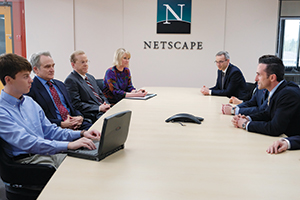Features & Columns
Boom & Bust
bubble and offers lessons on today's tech gold rush
 Two decades later, a new TV show plumbs the dotcom boom for lessons and a glimpse into the future.
Two decades later, a new TV show plumbs the dotcom boom for lessons and a glimpse into the future.
In the runup to the big IPO, Wall Street was buzzing. Plenty of traders believed in the social network and saw serious growth potential. Others were skeptical—dubious of the maturity and business acumen of the 20-something Ivy League grads behind the firm and unsure of the venture's entire premise.
How valuable could an online collection of photos, bulletin boards and chat rooms really be? Wasn't this just something college kids tooled around with before growing up and getting serious?
Then again, anyone who followed tech finance closely didn't want to miss out—as so many had when that search engine with the quirky name, Yahoo!, had gone public.
When trading opened, theGlobe.com's target share price was set at $9. The very first trade was made at $87. The stock closed the day at $63.50.
The date was Nov. 13, 1998. Seinfeld had just ended, Friends was going strong and NSYNC were brand new. Little more than a quarter of American homes had internet access—and about 16 million of those who did accessed the web with the help of a dial-up service called America Online.
The rise and demise of theGlobe.com is one of the main points of interest in the new docudrama Valley of the Boom, which is set to premiere Jan. 13 on the National Geographic channel. The six-part series—which features scripted acting and in-person documentary-style interviews with the real-life individuals whom the actors portray—follows the stories of three mid-'90s tech companies aiming to change the world.
Spoiler alert: all of them ultimately fall short of their goals.
THE CIRCLE
There are many parallels to be drawn between Silicon Valley's first mid-'90s boom and the tech sector's current state.
Unlike Mark Zuckerberg and Co., who launched Facebook at Harvard, theGlobe's founders—Stephan Paternot and Todd Krizelman—started their social network at Cornell. Their initial public offering came not in the wake of Google's massive debut, but in the wake of impressive IPOs from Netscape and Yahoo! Paternot and Krizelman were coached on what to wear before heading out on their IPO "roadshow," while Zuckerberg raised eyebrows by meeting with potential investors in a hoodie.
"I think we're kind of looping back around to a similar place, although all the players are different and a lot about today is different," says Matthew Carnahan, creator and director of Valley of the Boom.
Then as now, the media seized on narratives involving young startup founders making big bucks in their early 20s—and spending that money on lavish parties and outsize lifestyles. The show, which intersperses acting with straight-to-camera interviews with Arianna Huffington, Mark Cuban and the actual Paternot and Krizelman, also plucks choice TV news clips from the era. In one, a Los Gatos Ferrari dealer tells a reporter that he sold seven of the Italian luxury sports cars in a single afternoon.
Then, as now, there were struggles for power within the tech industry. Another Valley of the Boom narrative thread follows the so-called "Browser Wars" between Netscape, a Mountain View startup, and Microsoft. The Seattle-based tech titan would go on to use its heft to deliver a number of serious blows to Netscape's market share, drawing an antitrust case in the process. Though a district court ruled that Microsoft had engaged in anti-competitive practices by bundling its own in-house browser along with its operating system, the computing company ultimately came out ahead, as Netscape Navigator evaporated in the pink mist of the internet bubble's bursting.
And then, as now, the general public often had a tenuous-at-best grasp on the technology being sold to them. Valley of the Boom opens with a now infamous clip of Today co-hosts Katie Couric and Bryant Gumbel at a loss to explain the internet to themselves.
"What is internet, anyway?" Gumbel asks. "What do you—write to it, like mail?"
"I think that Silicon Valley is notoriously cyclical," says Leslie Berlin, project historian for Silicon Valley Archives at Stanford and author of Troublemakers: Silicon Valley's Coming of Age.
Even before the dotcom boom of the mid-'90s, the tech industry had its ups and downs, Berlin notes. But back then ordinary people didn't know or care who made the chips in their cars or their transistor radios, and for the most part they didn't care. The difference with Web 1.0 is that average investors got interested and the media ran with stories about exuberant spending by young Gen-X-ers.
Then, as now, there was a great deal of excitement for the potential of these companies. "That potential didn't exactly pan out," Berlin says.
 One of the primary narrative threads explored in 'Valley of the Boom' is the so-called 'Browser War' between the Mountain View-based startup Netscape and Seattle's tech titan, Microsoft.
One of the primary narrative threads explored in 'Valley of the Boom' is the so-called 'Browser War' between the Mountain View-based startup Netscape and Seattle's tech titan, Microsoft.
WEB 2.0
Paternot says its strange looking back on those early days of the internet. "Even email was a weird concept," he recalls. "People wrote each other by hand. There were these basic concepts that people couldn't get their heads around."
Much of that initial confusion has abated. People now pepper their daily conversations with internet jargon, complaining that they don't have enough "bandwidth" to deal with a given task or spitting out "lol" when mildly amused.
The public's understanding of the internet has grown hand-in-hand with their ability to access it—which has increased in parallel with technological improvements. Back when Paternot was taking theGlobe.com public, it cost about $50 to store a gigabyte of information on a hard drive, computer monitors were the size of a basketball or larger, dial-up was painfully slow and Wi-Fi was still nearly a decade down the road. Today, $50 buys an entire terabyte of storage and people carry ultra-powerful, always-connected computers in their pockets.
"You can't discount how important mobile is," Berlin says, noting that when marketers first came up with the concept of "Cyber Monday" back in 2005, they were relying on people shopping from their desktops at work. These days, Berlin continues, people can get their holiday shopping done on their phones from just about anywhere.
Indeed, mobile shopping is on the rise, nearing the 50 percent mark of all e-commerce. By 2021, analysts project that more than half of all online orders will be placed from a mobile device.
The role of money—and the ability to make money from the web—is also a major difference between the days of the first dotcom boom and today. Back then, aside from short-term stock market speculation, almost no one had figured out how to turn a profit yet.
Today it may seem obvious that the internet is an optimal portal for delivering advertisements, but back in the '90s, online marketing and online marketplaces were brand-new.
"It was hard to sell things online," Berlin says. Pop-up ads were obnoxious, and the coolest thing that a banner ad could do was flash wildly at a potential customer. The idea of clickable ads was something that had to be invented. And then there was the problem of getting potential advertisers interested in buying a spot.
Even Berlin, who at the time was already studying the tech industry, recalls having a conversation with her husband about this very topic. "Why on earth would anyone need a website when you have the Yellow Pages?" she remembers asking. "None of us understood what it was going to become."
In the two decades since the bottom fell out of Web 1.0, a handful of big vendors, like Amazon, have emerged to dominate the online marketplace. Meanwhile, advertising has proliferated across the internet. Audio ads pepper the free versions of music streaming services, video spots are tacked onto the beginning of popular YouTube clips, display ads run on just about every single website, and social media platforms track user behavior to deliver targeted ads.
That translates to revenue for the companies that have been able to best leverage the advertising power of the web. Google and Facebook are juggernauts thanks to online ads. As these companies have made money, they've funneled their profits into ensuring that the public understands how to and continues to use their products.
However, as people have become more comfortable with using the internet, personal privacy has suffered.
It's more than a bit ironic that now—after readily agreeing to so many incremental invasions—consumers are only beginning to push back in meaningful ways against encroachments on personal information. But, as Berlin notes, it is understandable. The tech industry is overwhelmingly preoccupied with charging headlong into the future, and consumers are eager to get on board with the next best thing, especially if it's cool and all their friends are in on the action.
"So much of what people are very concerned about," Berlin says, "about how much our tech knows about us, how our phone seems to know where we are—this stuff that is so scary to us right now; it was absolutely magical when it first came out. The first time I used Uber, I felt like I was looking at art in the making. It was so seamless and so beautifully integrated into the phone. Now, it's like: Is it tracking me?"
Or, to put it another way, Berlin continues: "If people think what you're doing is magic, at some point they are going to ask if you are tricking them.
BROWSER HISTORY
Valley of the Boom creator Carnahan is 57 years old. Both of his father's parents went to Stanford and he grew up in the East Bay. As a child living in Walnut Creek in the mid-'70s, he had a pet pig named Elizabeth. Once, when she fell ill, he and his family drove Elizabeth out to a veterinarian in the South Bay. "There were still farms," Carnahan says, remembering the trip.
Back then, there were some who referred to Santa Clara County as Silicon Valley. After all, long before Steve Jobs and Steve Wozniak founded their Apple Computer Company in a Palo Alto garage, William Hewlett and David Packard had begun their own electronics tinkering in a different Palo Alto garage.
And yet many who think about Silicon Valley—even those who work in the tech industry—forget about the region's long and storied history.
"As I've met a lot of engineers and founders and people in the VC world, I have found that a kind of an Achilles heel is that people in the valley don't tend to look back at all," Carnahan says, explaining his interest in telling the story of the first dotcom explosion. "They're very interested in looking forward. 'I'm going to push aside the past and trample on the present in order to get to the future. In the process I'm going to leave a lot of important knowledge on the table.' I think there's a lot to learn from the '90s tech boom and bust."
Perhaps the most important lesson is to remember that there are lessons to learn, Carnahan observes, trotting out the old maxim that those who do not learn from history are doomed to repeat it. "I think it's worth sifting through the ashes of these endeavors," he says.
There are plenty of cautionary tales of former giants that are no longer as powerful as they once were—if they are even still in business.
 Stephan Paternot co-founded theGlobe.com, one of the internet's very first social media platforms, which blew up big and then tanked when the dotcom bubble burst.
Stephan Paternot co-founded theGlobe.com, one of the internet's very first social media platforms, which blew up big and then tanked when the dotcom bubble burst.
Netscape's browser was initially the best in the game. The small company founded by Marc Andreessen and Jim Clark in 1994 initially captured the bulk of the market share in the emergent web browser space. However, by the turn of the millennium, Microsoft—which had not long before supplanted IBM as the top player in the computing world—achieved dominance in the market with its Internet Explorer browser.
At the height of the first dotcom bubble, it would have been hard to imagine that Apple and its operating system would ever pose a threat to Microsoft's Windows platform. But today, while Microsoft is no small actor, Apple is now the most valuable company in the world.
Facebook too is easily one of the world's largest tech firms, and yet in the wake of deep political divisions in America and around the world—and with evidence mounting that Facebook repeatedly ignored its responsibility for amplifying those divisions—the social network's popularity has begun to decline.
"It's hard to imagine a post-Google world; it's getting less hard for me to imagine a post-Facebook world," Carnahan says of the Menlo Park company that currently operates, in large part, out of Sun Microsystem's former headquarters. That sprawling bayside campus was once just one of many Sun outposts around the world; the once untouchable company was slurped into Oracle eight years ago.
Paternot certainly understands the fleeting nature of Silicon Valley dominance. After his company made waves with its IPO—which at the time marked the largest single-day gains in stock market history—theGlobe became just another casualty of overheated expectations.
"Netscape was a titan before they went down in flames, as was Yahoo," Paternot says. "People couldn't see the world past Nokia or Blackberry. How quickly one forgets."
FUTURE MARKETS
"We're entering a kind of internet 3.0 right now," Carnahan says. "I do think it's very possible that Facebook's moment has maybe passed—even though it is a massive company."
Paternot believes it is imperative that the next generation of web entrepreneurs learn from the mistakes of their forebears. Because right now, those pioneers are saying "Shit! What have we done? Now we're actually on a course correct."
The internet's futurebelongs not to those currently in power, according to Paternot, but to those who are ascendant within the tech world. These are millennials and members of the as-yet-unnamed Generation Z, who are tired of Facebook and resistant to volunteering so much of their personal information to faceless corporations. These people, Paternot says, are the adopters of the blockchain movement.
"We are back in 1994," he continues. "Just replace 'internet' with 'blockchain.' This is why looking back is so important."
While it's true that Silicon Valley moves in cycles, it also has the opportunity to improve upon itself with each new iteration. Blockchain technology, Paternot says, has already gone through its hype phase with the inflation and bursting of the cryptocurrency bubble. But there is so much more to blockchain than mining Bitcoins.
Blockchain's cryptography aspect adds a level of security that has been lost in the shuffle of Web 2.0. And its decentralized nature adds a further layer of privacy, as well as accountability.
Building decentralized apps—or "dapps"—for example promises to take the power out of the hands of large corporations, Paternot says. "The bigger you get, the more capital you attract, the more corruption you introduce to your system."
Building software on a decentralized platform essentially pulls an end-run around the big players and allows smaller developers to do things their own way, without having to deal with corporate gatekeepers.
Sure, he admits, the dapps that are currently available aren't all that impressive. But that is always the case with cutting edge technologies that emerge at the start of a new innovation cycle. People right now are mocking what blockchain can do, he says... just like how the haters mocked the very premise of theGlobe.com.
Carnahan says producing Valley of the Boom has given him cause for optimism—especially in the newest innovations he's been seeing. "I'm excited about new tech," he admits.
Then, at the same time, he is frightened to think that people have not only been freely feeding their pictures and political affiliations into social networks. When it comes to companies like 23andMe, he observes, people have been giving up their DNA.
"I think the stakes are very high," he says. "Honestly some of it scares the crap out of me."
Valley of the Boom
Jan 13, 9pm
National Geographic
nationalgeographic.com


